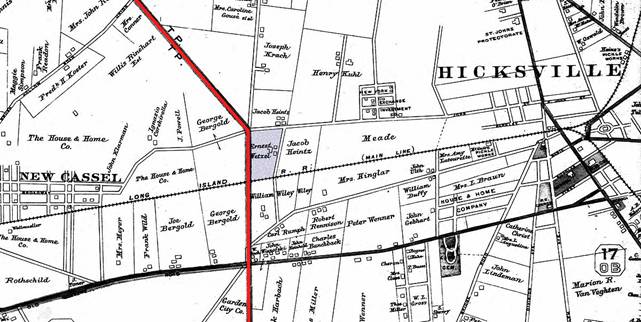To Hicksville
Eventually, everyone involved - the Towns, various members of the Jones family, the managers of the trust, and Albany - agreed upon a course of action: farmland in the Hicksville area would become the site of a new Jones Institute, and the Brookville property would be sold. Each Town provided $30,000 - ironically, the same amount as the original bequest - for the purchase.
The farm that was chosen had long been owned by Ernest Witzel and his wife Augusta. Around 1900, after running a milk business for many years, Witzel had given up that business in favor of farming full-time. Several years afterwards, he died suddenly. His widow eventually remarried, after which she sold her 25 acres of farmland to the Fund.
Site Chosen for the Jones Institute in Hicksville
Note that Ernest Witzel's name is misspelled on the map.
The red line marks the border between the
Townships of North Hempstead and Oyster Bay.
E. Belcher-Hyde, Atlas of Nassau County, NY, 1906
By the spring of 1915, the end of construction was in sight. As the sale of the Brookville property realized $65,000, substantially more than anticipated, an unplanned surplus remained in the building fund.

The Brooklyn Daily Eagle, September 16, 1915
The new red-brick structure was both graceful and imposing. There was plumbing(!), all the rooms let in sunlight and fresh air, it was only two stories tall (much to the delight of the residents' well-worn knees), and residents never had use a staircase to reach a bathroom. In addition, the home had its own on-site hospital. The 38 inmates were able to leave Brookville behind in August.
A frustrating financial crisis arose a few days before Christmas was first celebrated at the new home. The Eagle reported that the Institute found itself $4,000 in the red (one presumes that expenses had been harder to predict and control during the transition between the old and new facilities). The "unnecessary" surplus remained in the building fund, but it could not simply be re-purposed to pay an operating deficit. The situation was further complicated by the well-intentioned "strings" which the Towns had attached to their combined $60,000 contribution; one might even argue that their contribution was the source of the surplus. I have not found any report that details the manner in which the problem was resolved, but it evidently took time to devise a legal solution.
*
A curious situation arose in 1918: the Unincorporated Village of Glen Cove seceded from the Town of Oyster Bay to become the Incorporated City of Glen Cove. Its residents opted to remain part of the Jones Institute arrangement, and to continue provide tax support for it.
"Two Towns" had become "Two Towns and a City."
***

